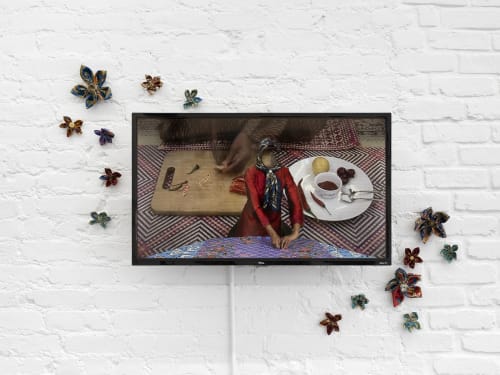Trotter&Sholer is pleased to announce Azzah Sultan’s representation and first solo show, Anak Dara in New York City. The term Anak Dara literally translates to virgin, but is used colloquially to mean young unmarried girl. Sultan works to explore the nuances of and re-frame the term in a contemporary context. Both the Malay word and the English word carry cultural baggage and assumptions. These assumptions are compounded for Sultan by elements of religious and cultural otherness. Sultan has spent most of her life intercultural space, living with her family in several different countries, and on her own in the United States.
The works in Anak Dara represent the body in its absence. The Melipat (to fold) series uses paint and draped fabric to create a hu- man form, without depicting the body itself. Each of these pieces as a self-portrait, based on images of the artist from her childhood dance practice. They are representations of her in the past, her now, and of the woman she hopes to become. By portraying herself in traditional Malaysian batik fabrics Sultan points to the cultural threads that are woven throughout her life. Sultan’s mother taught her daughters Malaysian dance as a means of staying connected to their culture as they lived and traveled internationally. The physical tie to culture is explored in this series through both the use of fabric and the body. For Sultan materiality helps to bridge the space between form and idea. An emphasis on material and physical expression helps to maintain cultural connection over distance and time.
The materials used in Anak Dara are significant. The Songket fabrc of the Menyentuh (to touch) series is a traditional Malaysian textile that is often woven silk with metallic gold and silver thread. It is worn only on special occasions. Sultan wrapped this important fabric around wooden stretchers and hand stitched images of her own hands in dance positions onto them. These works can also be read as self-portraits. Again, her face and body are not present, but the self is nonetheless present. The artists hands are integral to her work as an artist.
For Sultan, “erasing my face is not necessarily erasing my identity but creating a platform for others to see themselves within my image.” To this extent these pieces also do the work of cross-cultural communication. Viewers, Malaysian and non-Malaysian alike are invited to see themselves in Azzah’s images; to imagine the feelings of the fabrics. By removing the face, the notion of gaze is complicated. The viewer gazes at the subject of the work but can also imaginatively gaze out from within the piece. In this sense these pieces can also be understood as a disruption of the colonial gaze.

